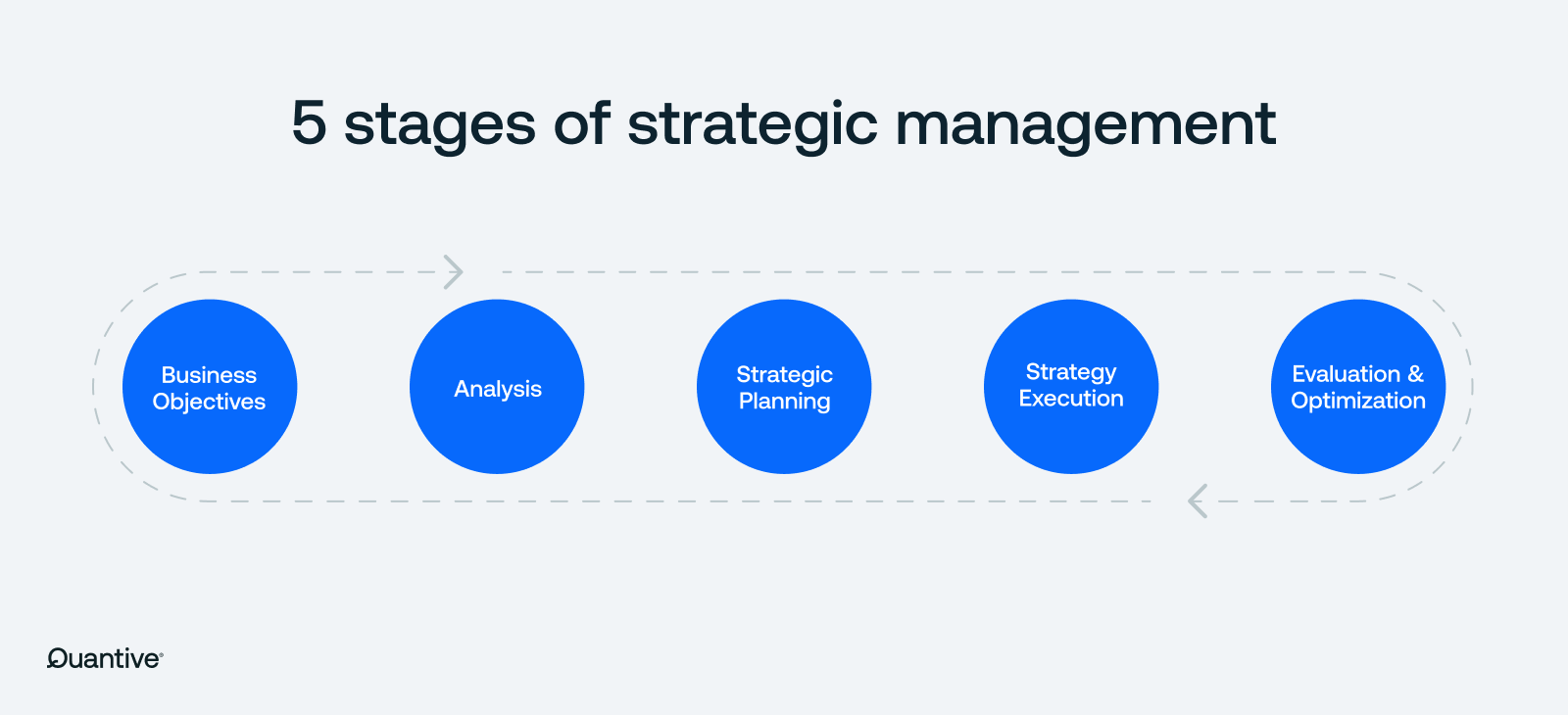Quantive is now part of WorkBoard. Get to know WorkBoard:
Achieving ambitious goals requires more than just determination; it demands an adaptable approach to navigating market complexities and internal capabilities.
As a leader, understanding and implementing strategic management is essential for driving your organization toward success. At Quantive, our mission is to empower companies to surpass their expectations by providing robust strategy management solutions. But what exactly is strategic management, and why is it crucial?
What is strategic management?
Strategic management is the comprehensive process of setting goals, developing plans, and executing strategies to achieve an organization's long-term strategic objectives. It involves a continuous cycle of analysis, planning, implementation, and evaluation to ensure that the company adapts to changing environments and maintains a competitive edge. This modern approach helps organizations align their resources and actions with their vision and mission.
Why is strategic management important?
Strategic management is important, because without a strategic plan, companies can waste time, money, and resources, without reaching their goals.
Constructing a building without a blueprint would be chaotic and inefficient. The blueprint provides a clear plan, detailing every aspect of the construction process.
In strategic management, your strategic plan is your blueprint; strategies, top-level goals, and action steps. It serves as a guide for the entire organization, ensuring that every effort contributes to the overall success of the business.
The five stages of the strategic management process
- Business objectives
- Analysis
- Strategic planning
- Strategy execution
- Evaluation and optimization
Business objectives
In order to successfully frame your strategic cycle, you will need your company mission, vision, and long-term business objectives. Start by revisiting the essence of what your business is and what it aspires to be. Then think about what goals could realistically advance these fundamental principles in the medium term. From there, define clear, specific, and actionable business objectives for your strategy cycle. You can set top-level objectives related to growth, market position, or other business outcomes, providing a direction for your strategic planning and execution.
Setting objectives:
- Growth: Determine your targets for revenue growth, market expansion, or customer acquisition
- Market position: Decide on your desired market share or industry ranking
- Business outcomes: Define other key outcomes, such as product innovation, operational efficiency, or customer satisfaction
Analysis
Conduct a thorough analysis of your internal capabilities and external environment. Quantive's solutions help you review your organization's strengths and weaknesses and understand market opportunities and threats, forming the foundation for effective strategies.
Internal analysis:
- Strengths: Identify your company’s core competencies and unique advantages
- Weaknesses: Recognize areas where your company lacks capabilities or resources
External analysis:
- Opportunities: Look for market trends, customer needs, and emerging technologies that your company can capitalize on
- Threats: Be aware of competitive pressures, regulatory changes, and economic fluctuations that could impact your business
Strategic planning
Create strategic plans based on insights from your analysis. Note that the insights from your analysis may lead you to revisit your top-level goals for your strategic cycle. Creating strategic plans from an analysis of your business context is no easy fit. It requires you to frame your decisions and plans effectively. Various strategic frameworks exist to strengthen your strategic decision-making. Quantive StrategyAI helps you evaluate different strategic options and select the ones that best fit your business needs and resources, drafting detailed plans and considering various scenarios.
Strategic planning process:
Evaluate options: Consider various strategic pathways and assess their potential impact
Select strategies: Choose the strategies that align with your business ambitions and leverage your strengths
- Draft plans: Develop detailed plans that outline the actions, timelines, and resources required for execution
- Scenario planning: Anticipate possible future scenarios and prepare contingency plans
Strategy execution
Execute your strategies with precision. This step, also called “strategy implementation” involves putting plans into action, coordinating efforts across departments, and managing resources effectively. Ensure that your strategy implementation plan includes specific actions, timelines, and responsible parties.
Execution framework:
- Action plans: Break down strategic plans into specific actions with clear timelines and responsibilities
- Alignment: Ensure cross-departmental collaboration and communication
- Resource management: Allocate resources efficiently to support strategic initiatives
- Monitoring: Keep track of progress and make adjustments as needed
Evaluation and optimization
Regularly assess the performance of your strategies using metrics and KPIs. Review progress towards goals, identify any issues or deviations, and make necessary adjustments. This step helps you stay aligned with your objectives and improve your strategic approach over time.
Evaluation Process:
- Performance metrics: Use KPIs to measure progress towards your goals
- Review: Conduct regular reviews to identify issues or deviations from the plan
- Adjustments: Make necessary adjustments to optimize strategy execution
- Continuous improvement: Foster a culture of continuous improvement by encouraging feedback and learning

Always-on strategic management
If your business is a high-performance racing car on a never-ending track, you likely aren’t relying on a single, rigid plan you laid out at the start of the race. Instead, you’re using your tech stack to monitor conditions, anticipate changes, and make instant decisions. You’re adjusting your strategy when necessary.
Strategic management must be an ongoing, rapidly iterative cycle that allows organizations to remain agile and responsive instead of a linear, step-by-step process. The speed at which businesses need to adapt and respond to market changes necessitates a more dynamic approach. This is where the concept of an "Always-On" strategy becomes crucial.
An agile approach ensures that your organization can quickly pivot and adjust its course as new opportunities and challenges arise. By implementing a fast loop around the traditional strategic management process, you can benefit from its theoretical foundations while effectively navigating the complexities of the modern market.
The combination of AI, data connectivity, and digital collaboration tools makes this nimble approach possible:
- AI can analyze vast amounts of information at unprecedented speed, providing insights that inform strategic decisions
- Data connectivity ensures that these insights are accessible across the organization
- Digital collaboration tools facilitate seamless communication and coordination among teams
Harnessing strategic management for organizational success
Strategic management is not just a theoretical concept; it's a practical tool for achieving business excellence. Bringing strategic management to your organization will align teams and ensure everyone contributes effectively to your business’ success.
- Informed decision-making: strategic management provides executives with a comprehensive understanding of their organization's strengths, weaknesses, opportunities, and threats. This analysis is vital for making informed decisions that drive growth and mitigate risks
- Clear objectives and direction: by defining clear business objectives, teams move with a sense of purpose and direction
- Effective resource allocation: invest in initiatives that offer the highest returns and align with the company's long-term vision
- Enhanced execution and coordination: executing strategies with precision requires coordinated efforts across various departments. Strategic management ensures that implementation plans are well-defined, timelines are set, and responsibilities are assigned, leading to seamless execution
- Continuous improvement: the evaluation and optimization step allows stakeholders to monitor progress, identify deviations, and make necessary adjustments
This iterative process fosters continuous improvement, helping the company stay agile and responsive to changes.
How do I enforce a strategic management process within my organization?
Enforcing strategic management starts with ensuring that your strategic vision permeates every level of the organization. Quantive helps you embed this context by integrating strategic goals into daily operations, making sure that every team member understands how their work aligns with the company’s top-level objectives. This alignment fosters a sense of ownership and commitment, ensuring that everyone is working towards the same objectives.
With real-time tracking tools and dashboards that offer insights into performance metrics and KPIs, continuous visibility allows you to identify and address any deviations from the plan promptly, keeping your strategy on course.
Strategic agility is crucial
Strategic agility is essential for organizational success. Imagine your brand as a grand ship embarking on a transformative voyage across a vast ocean. The goal is to explore new territories, evolve your offerings, and adapt to the ever-changing tides of customer habits, competition, and market dynamics. With strategic management, you have a well-prepared expedition–you chart the course by studying maps, understanding weather patterns, and assessing the ship’s strengths and weaknesses. The crew prepares for different conditions and challenges, ensuring they have the necessary supplies and contingencies in place.
Without strategic management, your team sets off on an aimless drift. They face unforeseen storms and obstacles, leading to a chaotic and unprepared journey.
Strategic management needs to go beyond the traditional step-after-step model, which stretches planning over months and execution over quarters with little to no evaluation and optimization in between.
By implementing an Always-On Strategy, you empower your teams to execute your vision flawlessly whilst empowering them to navigate market changes. With the help of Quantive StrategyAI, you can identify hidden trends and uncover previously unseen opportunities at any stage to gain a decisive strategic advantage.
Quantive empowers modern organizations to turn their ambitions into reality through strategic agility. It’s where strategy, teams, and data converge to drive effective decision-making, streamline execution, and maximize performance.
In today’s competitive landscape, having an Always-On Strategy is crucial for bridging the gap between current and desired business outcomes. Quantive combines technology, expertise, and passion to transform your strategic management from a static formulation into a feedback-driven engine for growth.
Whether you’re a fast-growing scale-up, a mid-market business looking to conquer new markets, or a large enterprise seeking innovation, Quantive keeps you ahead—every step of the way.
For more information, visit www.quantive.com.





